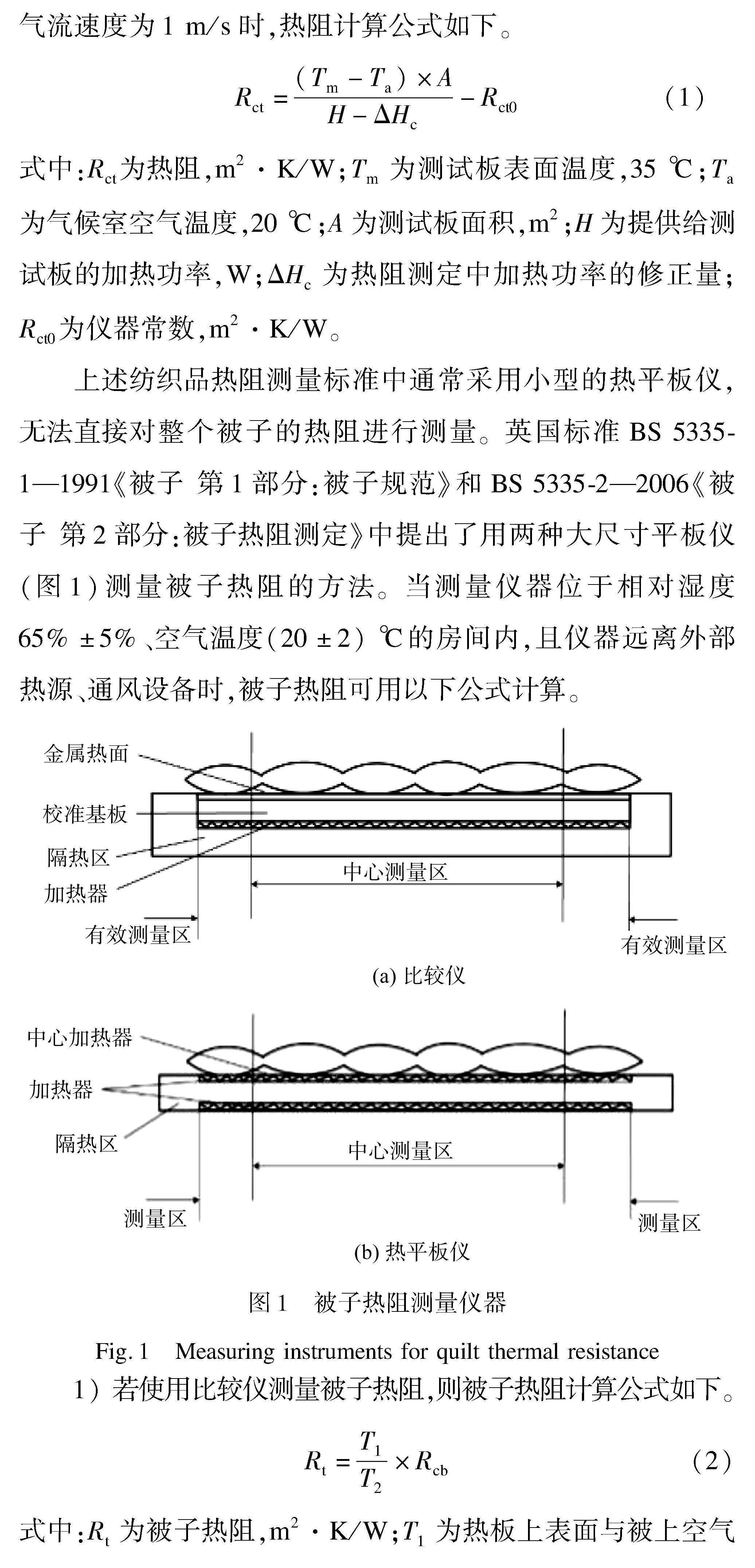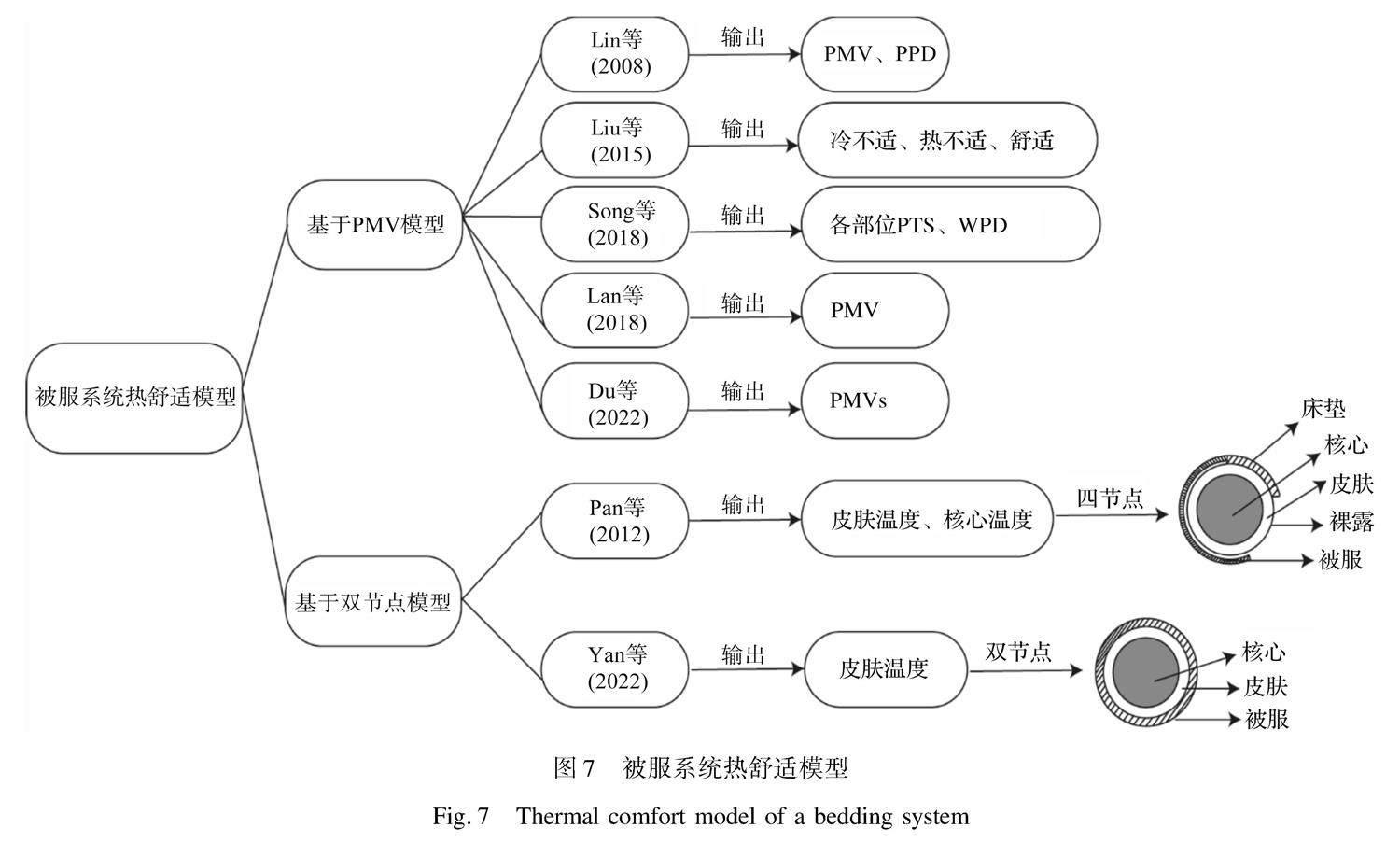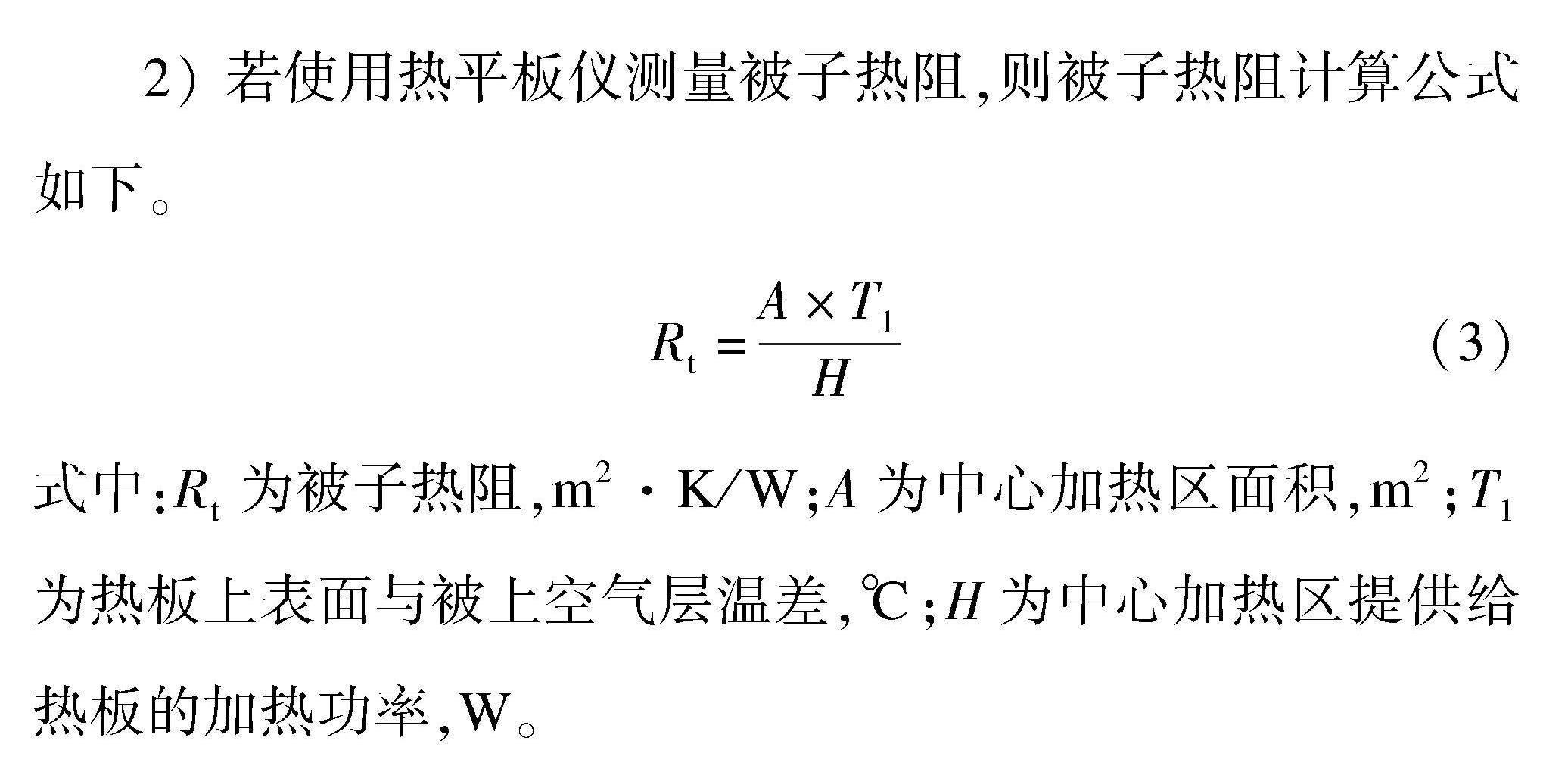被服系统热舒适性测评方法研究进展
周琴 郑晴 严芳英 柯莹



Research progress on thermal comfort evaluation methods of the bedding system
摘要:
为了对睡眠人体热舒适进行准确评估,提高睡眠质量,文章研究了被服系统热舒适性的测评方法。首先总结和分析了被服系统的热阻测量方法,包括热平板法、暖体假人测试法和数值模型预测法。其次,探讨了基于人体热反应的热舒适性测评方法,包括主观热评价、热生理评价和睡眠姿势监测评价,阐述了目前用于被服系统热舒适预测的数学模型。最后,剖析当前研究的不足,提出未来被服系统热舒适性测评方法的研究应从被服系统热阻的测定、非接触式的睡眠热舒适评价、机器学习算法的应用3个方面展开。
关键词:
被服系统;热舒适性;测评方法;热阻;人体热生理
中图分类号:
TS941.17
文献标志码:
A
文章编号: 1001-7003(2024)06-0059-10
DOI: 10.3969/j.issn.1001-7003.2024.06-.007
收稿日期:
20231004;
修回日期:
20240429
基金项目:
教育部人文社会科学研究青年基金项目(20YJCZH063);江苏省第六期“333”人才培养支持资助优秀青年人才项目(苏人才办〔2022〕21号)
作者简介:
周琴(2000),女,硕士研究生,研究方向为纺织品热舒适性。通信作者:柯莹,副教授,keying0312@163.com。
睡眠与人体身心健康密切相关[1],睡眠不足会增加患心血管疾病[2]、冠心病[3]、肥胖及2型糖尿病[4]的风险,还会损害情绪调节[5]及认知能力[6]。因此,有必要采取合理有效的手段改善人的睡眠质量。
被服系统是指人体睡眠时所需的寝具及服装,一般包含床、床垫、床单、枕头、覆盖物(如被子和毯子)与睡衣等,它们共同构成被下微环境,影响人体与室内环境的热交换[7]。以往研究大多强调室内环境对睡眠质量的影响[8],然而被服系统对睡眠人体的睡眠质量有着更显著的作用[9-10]。被服系统建筑围栏式的结构使得睡眠人体的热舒适在很大程度上由被服系统决定。被服系统热舒适对睡眠人体的总睡眠时长、入睡潜伏期、深度睡眠时长、睡眠觉醒、睡眠效率及主观睡眠质量均有重要影响。研究表明,高温环境下,通过局部冷却提高被服系统热舒适性可以使总睡眠时间增加52 min,入睡潜伏期减少17 min,睡眠觉醒时间减少37 min,深度睡眠时间增加26 min,睡眠效率提高10.7%,主观睡眠质量也得到显著改善[11]。低温环境下,床垫加热和被子加热可以使总睡眠时间增加35 min,入睡潜伏期减少18 min,入睡后的觉醒时间减少28 min,睡眠效率提高5%[12-13]。同时,也有学者对被下微环境热中性温度展开研究,但由于各地气候条件、被服系统和睡眠习惯的差异,该中性温度并未形成统一标准[9,14-16]。由此可见,被服系统热舒适性仍有待深入研究。
然而,目前对被服系统热舒适的研究中,测试评价方法不尽相同,且还未有相关标准可供参考。因此,本文对国内外相关文献进行了综述,从被服系统热阻测量和睡眠人体热舒适评价两个方面,总结分析了被服系统热舒适性测评方法,以期为被服系统热舒适性研究选择最适用的评价方法提供参考。
1 被服系统的热阻测定
被服系统热阻直接反映了被服系统的隔热性能,影响着睡眠人体与外界环境的热交换,从而影响睡眠人体的热舒适。被服系统的热阻与最佳睡眠空气温度密切相关。有研究表明,被服系统热阻越大,最佳空气温度越低,被服系统热阻每增加1 clo,最佳空气温度降低5.3 ℃[17-18]。室内空气温度过低时,如果被服系统热阻也过低,则此时被服系统热舒适性较差。而被服系统热阻过高同样也会降低被服系统热舒适性,从而对人体健康造成不利影响,如过多的覆盖可能会造成睡眠人体热应激。由此可见,选择合适的被服系统热阻对被服系统热舒适性具有重要作用。然而,受床垫、被子、睡衣及覆盖率等因素的影响,不同组合的被服系统热阻差异较大[19],且目前没有针对被服系统热阻的测定标准和完整数据库。因此,对被服系统热阻测定方法进行总结分析有利于被服系统热舒适性的研究。被服系统热阻测定方法通常分为三类:热平板法、暖体假人测试法和数值模型预测法。
1.1 热平板法
热平板法可用于测量被服系统内各种纺织品材料的热阻,如睡衣、床垫及其他纤维集合体材料。ISO 11092—2014《纺织品生理效应稳态条件下耐热和耐水蒸气性能的测量(防护热板排汗试验)》和GB/T 11048—2018《纺织品生理舒适性稳态条件下热阻和湿阻的测定(蒸发热板法)》均对用热平板测量纺织品热阻的方法进行了规定:在相对湿度65%、气流速度为1 m/s时,热阻计算公式如下。
Rct=(Tm-Ta)×AH-ΔHc-Rct0(1)
式中:Rct为热阻,m2·K/W;Tm为测试板表面温度,35 ℃;Ta为气候室空气温度,20 ℃;A为测试板面积,m2;H为提供给测试板的加热功率,W;ΔHc为热阻测定中加热功率的修正量;Rct0为仪器常数,m2·K/W。
上述纺织品热阻测量标准中通常采用小型的热平板仪,无法直接对整个被子的热阻进行测量。英国标准BS 5335-1—1991《被子第1部分:被子规范》和BS 5335-2—2006《被子第2部分:被子热阻测定》中提出了用两种大尺寸平板仪(图1)测量被子热阻的方法。当测量仪器位于相对湿度65%±5%、空气温度(20±2) ℃的房间内,且仪器远离外部热源、通风设备时,被子热阻可用以下公式计算。
1) 若使用比较仪测量被子热阻,则被子热阻计算公式如下。
Rt=T1T2×Rcb(2)
式中:Rt为被子热阻,m2·K/W;T1为热板上表面与被上空气
层温差,℃;T2为热板下表面与热板上表面温差,℃;Rcb为校准板热阻,m2·K/W。
2) 若使用热平板仪测量被子热阻,则被子热阻计算公式如下。
Rt=A×T1H(3)
式中:Rt为被子热阻,m2·K/W;A为中心加热区面积,m2;T1为热板上表面与被上空气层温差,℃;H为中心加热区提供给热板的加热功率,W。
通过热平板仪测量被服系统中各种纺织品热阻的方法简单易操作,但无法直接反映被服系统整体热阻。此外,影响被服系统热阻的因素繁多,各种纺织品热阻与被服系统整体热阻的关系尚不明确。
1.2 暖体假人测试法
利用暖体假人测量被服系统热阻是目前最常用的方法。虽然还没有关于使用暖体假人测量被服系统热阻的标准,但许多相关标准都为其提供了参考,如ASTM F1291《利用暖体假人测量服装隔热性能的标准试验方法》与ISO 15831《服装生理效应用暖体假人测量隔热性》规定了使用暖体假人测量服装热阻的测试方法,ISO 9920《热环境的人类工效学服装隔热性和蒸发阻力评估》提供了服装整体热阻的估算方法,以及ISO 23537《睡袋要求》和GB/T 38426《睡袋的热阻和使用温度的测定方法》规定了使用暖体假人测定睡袋热阻的方法。
Lin等[19]利用暖体假人测量了亚热带地区常用被服系统的热阻,建立了亚热带地区常见被服系统总热阻的小规模数据库,如图2所示,该数据库目前已被许多研究者用于进一步研究;Zhang等[7]利用暖体假人测量了64组被服系统的热阻(图3),并根据测量数据建立了被服系统热阻评估模型,进一步丰富了被服系统总热阻数据库。此外,也有研究者开展了被服系统热阻影响因素的研究。Lu等[20]使用暖体假人研究了填充材料和人体姿势对被服系统总热阻和局部热阻的影响(图4),发现羽绒、羊毛和蚕丝被对被服系统总热阻的影响存在显著性差异,并建立了以被子填充物质量为自变量的被服系统总热阻预测方程,而不同人体姿势下被服系统的局部热阻也存在显著差异,为被服系统的设计与选择提供了参考。
目前,使用暖体假人测量的被服系统总热阻,能较为直接地评估被服系统的热舒适性,且具有较强的可重复性。然而,暖体假人使用成本较高,测量条件苛刻,大量企业不具备使用暖体假人的条件,因此该方法的推广使用存在局限性。
所测被服系统总热阻(clo)
不同被服系统23.3%48.0%59.0%67.0%79.9%88.0%94.1%100%
M1+Q1+S1
M1+Q2+S1
M1+B+S11.57
2.152.722.883.273.994.564.77
1.842.242.412.813.323.734.06
1.822.082.182.222.412.562.65
M1+Q1+S2
M1+Q2+S2
M1+B+S21.38
1.652.152.623.183.794.344.60
1.531.932.202.683.263.553.92
1.431.761.802.072.362.402.58
M1+Q1
M1+Q2
M1+B0.98
1.161.431.902.443.684.034.47
1.141.421.691.982.953.033.62
1.071.241.451.651.982.112.23
M2+Q1+S1
M2+Q2+S1
M2+B+S11.31
1.631.972.322.573.083.323.64
1.611.932.192.422.662.973.12
1.551.741.811.922.122.212.31
M2+Q1+S2
M2+Q2+S2
M2+B+S21.18
1.511.902.202.532.913.263.60
1.501.731.992.282.612.833.04
1.461.621.641.872.022.102.19
M2+Q1
M2+Q2
M2+B0.90
1.091.351.832.062.673.003.26
1.071.271.581.812.342.502.76
1.041.181.301.451.741.841.90
M1+Q3+S11.572.392.863.083.534.154.664.89
注:M1为传统床垫,M2为棕绑床垫;S1为长袖睡衣,S2为半袖睡衣;B为毯子,Q1为夏季被1,Q2为夏季被2,Q3为多功能被。
所测被服系统总热阻(clo)
不同被服系统94.1%85.9%70.6%54.4%
P12.742.141.751.53
P23.302.552.021.70
P34.093.012.231.75
P44.393.062.401.78
D13.352.451.981.74
D23.952.762.281.80
D34.493.142.371.85
C13.702.802.211.71
C24.593.392.451.82
C34.893.472.571.85
P1+QC2.81——1.56
P2+QC3.51——1.77
P3+QC4.24——1.83
P4+QC4.55——1.94
P1+QC+S13.10——1.61
P2+QC+S13.71——1.80
P3+QC+S14.43——1.92
P4+QC+S14.61——1.99
P1+QC+S23.11——1.70
P2+QC+S23.73——1.92
P3+QC+S24.44——2.15
P4+QC+S24.65——2.23
注:P1、P2、P3、P4为涤纶被,质量分别为0.996、1.544、2.372、2.774 kg;D1、D2、D3为羽绒被,质量分别为1.495、1.904、2.946 kg;C1、C2、C3为棉被,质量分别为1.940、2.894、3.988 kg;S1为半袖睡衣,S2为长袖睡衣;QC为被套。
所测被服系统总热阻(clo)
填充材料方程
羽绒Rt=0.731lnw-0.442
蚕丝Rt=0.725lnw-1.152
羊毛Rt=0.392lnw-1.083
所测被服系统总热阻(clo)
人体姿势方程
ARt=0.731lnw-0.442
BRt=0.666lnw-0.030
CRt=0.798lnw-0.440
DRt=0.273lnw-0.648
1.3 数值模型预测法
考虑到暖体假人测试法的局限性,Pan等[21]提出用数值模型预测被服系统总热阻。如图5所示,模型假设被服系统截面为梯形,人体截面为矩形,睡衣热阻忽略不计,人体皮肤表面温度均匀。该模型包含了被服系统覆盖人体面积、床垫及被子类型等影响被服系统总热阻的因素,并利用前人实验结果[19]对模型预测结果进行验证,结果表明该数学模型误差小于10%;Zheng等[22]基于三维虚拟试衣技术构建了更符合实际的被服系统几何模型,从而进一步构建了被服系统总热阻和局部热阻的预测模型。
数值模型预测法使被服系统热阻的评估更加简便,但其
对被服系统的限制导致其应用范围有限。
2 睡眠人体热反应测评
热舒适受物理、生理和心理等因素的影响[23]。因此,除了被服系统热阻,被服系统的热舒适性评价还需要基于睡眠人体的生理和心理进行。大量研究表明,睡眠期的平均皮肤温度比清醒状态高1℃左右,热舒适投票高0.6左右,热感觉投票也较清醒时高[24-25]。因此,睡眠人体热反应测评方法对被服系统热舒适性评价十分重要。睡眠人体热反应测评的常用方法有通过填写主观问卷的主观热评价、通过评估睡眠人体皮肤温度和核心温度的热生理评价,以及近年来随着计算机技术的发展,结合主观问卷开发出的睡眠人体睡眠姿势监测评价、考虑主观评价及客观温度的热舒适模型。
2.1 主观热评价
主观热评价通常采用问卷的形式,测试受试者的热状态。美国采暖、制冷与空调工程师学会(ASHRAE)提出热感觉、热舒适、热偏好与热满意度评价量表以评估人体热舒适(图6),已得到广泛使用[26]。
目前针对主观睡眠热舒适性的研究一般是通过收集受试者睡前及第二天早上醒来后根据对前一晚睡眠的回忆填写的主观热评价量表。但通过回忆进行主观热评价的可靠性仍有
待考证。Song等[13]利用主观热评价方法研究睡眠热舒适与睡眠质量的关系,发现入睡潜伏期与热感觉呈线性相关,稍暖的感觉有助于入睡;Lan等[27]发现,在睡眠状态中,人体舒适时的热感觉比睡眠前高。另外,在被服系统局部热舒适性的研究中,Song等[28]发现人体各部位的热感觉有所不同,胸部、背部、臀部和大腿的热感觉高于面部,而背部、面部、大腿是与被覆盖身体热感觉相关性最高的三个部位,这一发现将有利于进一步开展用局部热感觉评估睡眠人体整体热感觉的研究。
主观热评价方法简单便捷,然而受身体状况、心理状态和年龄等因素的影响,其结果受个体影响较大,易产生误差。其次,量表很难应用于实时热舒适预测。因此,有必要与其他热舒适测评方法相结合,综合评估睡眠人体热舒适性。
2.2 热生理评价
与主观评价相比,采用热生理评价可持续监测睡眠人体热状态,并实现热感觉实时预测,从而评估人体瞬时热舒适状态。皮肤温度、核心温度等是评估睡眠人体热舒适的主要热生理指标[29],表1列出了近几年被服系统热舒适性研究中使用的评价方法。
2.2.1 皮肤温度
皮肤温度作为反映人体对环境冷热刺激反应的重要生理参数,是评价热舒适性的重要生理指标之一[37]。在睡眠热舒适性的研究中,常用平均皮肤温度(MST)作为评价指标。MST采用局部皮肤温度的加权平均值进行计算,包括3点、4点、7点、10点、15点等计算方法,使用不同的计算方法会得出不同的结果。为了探索最适合用于人体热舒适性研究的MST计算方法,Liu等[38]通过可靠性、灵敏度及测量点数量3个指标,评估了用于计算MST的不同公式,并表明最佳MST计算公式为10点加权公式。然而,Liu等的评估是基于清醒人体实验数据进行的,在实际睡眠中,测量10个局部皮肤温度会对人体睡眠造成较大干扰,因而在睡眠实验中使用较多的是Hardy等的7点法[39]。基于7点法,Lan等[33]提出了一种用于睡眠人体热舒适评价的3点MST计算方法,该方法简单方便,并具有一定的可靠性。表2列出了睡眠人体热舒适评价中常用的MST计算公式。
注:Tsk为平均皮肤温度,℃;tforehead为前额温度,℃;tupperarm为上臂温度,℃;tforearm为前臂温度,℃;thand手部温度,℃;tback为背部温度,℃;tchest为胸部温度,℃;tabdomen为腹部温度,℃;tthigh大腿温度,℃;tcalf小腿温度,℃;tfoot脚部温度,℃;l表示左,r表示右。
睡眠人体的皮肤温度与睡眠质量存在显著相关性。大量研究表明皮肤温度升高能使人更快地进入睡眠状态[40]。睡眠期间,皮肤温度也会随着睡眠阶段的不同而变化。在快速眼动阶段(REM),皮肤温度升高,升高的幅度取决于环境温度,一般在0.5~2 ℃,[41]。此外,睡眠期间的皮肤温度变化会对睡眠质量产生影响,Candas等[42]发现快速眼动期皮肤温度的变化可能会导致睡眠中断,且过低的皮肤温度比过高的皮肤温度更容易导致睡眠中断。
通过在不同环境温度下对主观热感觉和MST进行研究,许多学者发现MST与热感觉呈正相关,并得出当睡眠环境温度处于16~21 ℃时,最佳MST为34.6 ℃[13,33];当睡眠环境温度处于21~29 ℃时,最佳MST为32.6~33.7 ℃[30]。此外,还有学者对睡眠期间的局部皮肤温度进行了研究,Xu等[34]计算了前额、手、前臂、小腿、大腿、脚与胸部之间的温度梯度,发现入睡前四肢与胸部之间的皮肤温度梯度逐渐升高,前额与胸部的皮肤温度梯度逐渐降低,睡眠期间各部位与胸部的皮肤温度梯度相对稳定,醒后逐渐降低。由此可见,皮肤温度梯度在睡眠热舒适研究中也有重要作用。
2.2.2 核心温度
核心温度反映了人体内部的温度[43]。根据测量部位的不同,目前可用于表示核心温度的有口腔温度、鼓膜(或耳蜗)温度、直肠温度、胃肠温度、膀胱温度、食道温度、肺动脉温度等[44-45]。
研究发现,睡眠常伴随着核心温度的降低[46]。睡眠的开始与核心温度下降密切相关,在进入睡眠状态后,核心温度也会继续下降以延续睡眠时长,到达最低点后开始上升,几个小时后人会醒来。睡眠期间的核心温度一般总是维持在36.2~36.8 ℃[41]。此外,Song等[13]的研究表明,在0.1~0.4 ℃,核心温度下降越多,睡眠热舒适性越好,睡眠效率越高,慢波睡眠(SWS)时间更长。这与Krauchi[47]的研究结果相同,即核心温度下降越快,深度睡眠时间越长,主观睡眠质量越好。
2.3 睡眠姿势监测
目前睡眠热舒适性检测主要使用可穿戴设备测量生理参数进行接触式检测,然而这种方法会加剧个人睡眠障碍[48]。由于睡眠时的热舒适也与睡眠姿势密切相关[49],有研究者采用睡眠姿势评价研究睡眠热舒适性,并基于视觉感知开发了热舒适检测算法。
Cheng等[50]通过身体姿势、身体覆盖面积和手臂与被子的关系定义了10种热不适时的睡眠姿势,并利用骨骼关键点建立了人体姿势估计算法以评估睡眠人体的热舒适,该算法的平均准确率达到91.15%。
但目前这种基于睡眠姿势的热舒适性检测算法所定义的热不适姿势有限,因此,在未来研究中可以扩充数据集,定义更多睡眠热不适时的睡眠姿势。
2.4 热舒适模型
传统热舒适模型一般基于数学方程或实验数据建立。近年来,随着机器学习技术的发展,也有部分机器学习算法用于热舒适模型研究[51]。基于机器学习算法的热舒适模型不同于传统模型,它具有个性化、动态预测和高准确率等特点。如Chaudhuri等[52]通过测量手部皮肤温度、脉搏率及环境温度,基于支持向量机算法,提出个人热舒适预测方法(ePTS),ePTS模型准确率超过97%;Shan等[53]将机器学习算法与脑电结合,进行个人实时热舒适状态预测,并比较了线性判别分析、朴素贝叶斯和K-最邻近算法的预测性能,发现各算法的准确率均在90%以上。但上述热舒适模型主要针对清醒人体,目前用于被服系统热舒适评价的模型仍以传统热舒适模型为主,分为两类:一类是基于PMV模型进行修正的模型,另一类是基于Gagge双节点模型进行改进的人体热调节模型,如图7所示。
PMV模型主要用于评估均匀和稳态的热环境下人体的热舒适性[54]。Lin等[17]对Fanger的PMV模型进行修改,开发了适用于睡眠环境的PMV-PPD热舒适模型;Liu等[30]采用马氏距离判别法建立了基于MST评估个人热舒适的PMV模型;Song等[55]考虑局部热感觉,建立了睡眠热舒适的局部热感觉和整体不满意率模型(PTS-WPD模型);Lan等[56]基于被服系统两部分模型开发了预测睡眠人体热中性的模型。然而,在不同空气流速下使用Lin和Lan的模型预测睡眠期间人体热舒适性时存在显著偏差,因此Du等[35]考虑气流速度,建立了PMVs模型,该模型对不同气流速度条件下睡眠人体的热舒适性具有良好的预测性。
与清醒人体不同,睡眠人体的体温调节依赖于睡眠阶段[57],因此需要开发适用于睡眠人体的热调节模型。Pan等[58]在Gagge双节点模型的基础上,开发了用于预测睡眠人体热生理反应的四节点热调节模型,通过预测的核心温度及皮肤温度可以评估人体热舒适。Yan等[36]将Gagge双节点模型的相应参数替换为仰卧睡眠人体对应的值,使其更适应睡眠环境和睡眠人体生理参数的变化,并发现在17~30 ℃的热环境中该模型对睡眠人体热舒适性具有较好的预测效果。
3 研究展望
目前,关于被服系统的热舒适性,已有一些学者展开了研究,并提供了多种被服系统热舒适性测评方法,为未来进一步研究提供了较多选择和参考。本文基于上述分析,提出以下展望。
3.1 被服系统热阻测定方法的研究
当前被服系统热阻的测定主要采用暖体假人,但在实际操作中,环境条件、假人睡眠姿势、被子覆盖人体面积比例、被服系统构成等细节的设定不尽相同,缺乏统一标准,导致相关研究之间无法直接比较,未来可建立基于暖体假人的被服系统热阻测试标准。此外,利用预测模型测定被服系统热阻较为简便,但现有模型主要考虑被子、床垫、被子覆盖人体面积等影响因素,无法反映所有影响被服系统热阻的因素,也无法覆盖所有类型的被服系统,准确度和应用范围有待进一步提高。
热与湿是相互影响的,除了被服系统热阻,被服系统湿阻也是一个重要的客观指标[59]。然而,目前对于湿阻的测定主要针对被服系统内各纺织品,而对被服系统整体湿阻的测定方法较为缺乏。因此,未来可研究被服系统湿阻的测定方法,以探讨湿阻对被服系统热舒适性的影响。
3.2 非接触式的睡眠热舒适评价
非接触式的睡眠热舒适评价方法,如睡眠姿势监测,对人体干扰小,极具推广应用潜力。但目前关于睡眠姿势和热舒适的研究仍处于探索阶段,准确度有待进一步提高,需要扩大所研究的被服系统和人群范围。同时,未来可将非接触睡眠热舒适评价系统与调温设备结合,从而更合理地调控室内温度,以提高睡眠质量和睡眠热满意度,降低建筑能耗。
3.3 机器学习算法的应用
与传统热舒适模型相比,基于机器学习算法的热舒适模型不仅准确率高,还在个性化热舒适预测中展现出极大优越性。在未来研究中,可开发基于机器学习算法的被服系统个性化热舒适模型,从而更好地预测个人睡眠热舒适。此外,还可以将其嵌入软件系统中,通过各类硬件设备的作用,研发个性化智能调温的被服系统,实时调控被服微环境,提高个人睡眠热舒适性。
4 结 语
鉴于被服系统热舒适性对睡眠的重要性,本文对被服系统热舒适性测评方法进行了归纳总结和分析,并进行了研究展望。首先,总结了影响被服系统热舒适性的物理因素,即被服系统热阻测定方法,包括热平板法、暖体假人法和模型预测法,表明现有热阻预测模型的准确度和应用范围有待提高;其次,系统性地总结了被服系统热舒适性的心理和生理测评方法,并总结了目前国内外学者取得的研究进展,表明基于视觉的非接触式测评方法是未来研究重点,以及机器学习算法在热舒适模型中的应用潜力。尽管被服系统热舒适性测评方法已取得一些发展,但仍面临测试评价标准不统一等挑战,未来需要建立统一的被服系统热阻测试标准和被服系统热舒适性评价标准。
参考文献:
[1]SHIMIZU Y, YAMAMURA R, YOKOI Y, et al. Shorter sleep time relates to lower human defensin 5 secretion and compositional disturbance of the intestinal microbiota accompanied by decreased short-chain fatty acid production[J]. Gut Microbes, 2023, 15(1): 2190306.
[2]NARANG I, MANLHIOT C, DAVIES-SHAW J, et al. Sleep disturbance and cardiovascular risk in adolescents[J]. Canadian Medical Association Journal, 2012, 184(17): E913-E920.
[3]MILLER M, CAPPUCCIO F. Biomarkers of cardiovascular risk in sleep-deprived people[J]. Journal of Human Hypertension, 2013, 27(10): 583-588.
[4]BECCUTI G, PANNAIN S. Sleep and obesity[J]. Current Opinion in Clinical Nutrition and Metabolic Care, 2011, 14(4): 402-412.
[5]GOLDSTEIN A, WALKER M. The role of sleep in emotional brain function[J]. Annual Review of Clinical Psychology, 2014, 10: 679-708.
[6]DE BRUIN E, RUN C, STAAKS J, et al. Effects of sleep manipulation on cognitive functioning of adolescents: A systematic review[J]. Sleep Medicine Reviews, 2017, 32: 45-57.
[7]ZHANG N, CAO B, ZHU Y. An effective method to determine bedding system insulation based on measured data[J]. Building Simulation, 2023, 16(1): 121-132.
[8]CADDICK Z, GREGORY K, ARSINTESCU L, et al. A review of the environmental parameters necessary for an optimal sleep environment[J]. Building and Environment, 2018, 132: 11-20.
[9]WANG Y, LIU Y, SONG C, et al. Appropriate indoor operative temperature and bedding micro climate temperature that satisfies the requirements of sleep thermal comfort[J]. Building and Environment, 2015, 92: 20-29.
[10]BISCHOF W, MADSEN T L, CLAUSEN J, et al. Sleep and the temperature-field of the bed[J]. Journal of Thermal Biology, 1993, 18(5/ 6): 393-398.
[11]LAN L, QIAN X, LIAN Z, et al. Local body cooling to improve sleep quality and thermal comfort in a hot environment[J]. Indoor Air, 2017, 28(1): 135-145.
[12]XIA L, LAN L, TANG J, et al. Bed heating improves the sleep quality and health of the elderly who adapted to no heating in a cold environment[J]. Energy and Buildings, 2020, 210: 109687.
[13]SONG C, ZHAO T, SONG Z, et al. Effects of phased sleeping thermal environment regulation on human thermal comfort and sleep quality[J]. Building and Environment, 2020, 181: 107108.
[14]李净, 刘艳峰, 宋聪, 等. 西北民居冬季睡眠被褥微气候研究[J]. 建筑科学, 2016, 32(2): 65-69.
LI J, LIU Y F, SONG C, et al. Winter bedding microclimate in rural houses in northwest China[J]. Building Science, 2016, 32(2): 65-69.
[15]ZHANG N, CAO B, WANG Z, et al. Effects of bedding insulation and indoor temperature on bed microclimate and thermal comfort[J]. Energy and Buildings, 2020, 223: 110097.
[16]ZHANG H Y, SHEN L M. Effect of gender and body part differences on skin temperature and bed micro-environment during sleep in a moderate temperature environment[J]. Energy and Buildings, 2023, 297: 113459.
[17]LIN Z, DENG S. A study on the thermal comfort in sleeping environments in the subtropics: Developing a thermal comfort model for sleeping environments[J]. Building and Environment, 2008, 43(1): 70-81.
[18]PAN D, CHAN M, DENG S, et al. Numerical studies on the microclimate around a sleeping person and the related thermal neutrality issues[J]. Ergonomics, 2011, 54(11): 1088-1100.
[19]LIN Z, DENG S. A study on the thermal comfort in sleeping environments in the subtropics: Measuring the total insulation values for the bedding systems commonly used in the subtropics[J]. Building and Environment, 2008, 43(5): 905-916.
[20]LU Y, NIU M, SONG W, et al. Investigation on the total and local thermal insulation of the bedding system: Effects of filling materials, weights and body postures[J]. Building and Environment, 2021, 204: 108161.
[21]PAN D, LIN Z, DENG S. A mathematical model for predicting the total insulation value of a bedding system[J]. Building and Environment, 2010, 45(8): 1866-1872.
[22]ZHENG Q, WANG H, KE Y. Prediction of the local and total thermal insulations of a bedding system based on the 3D virtual simulation technology[J]. Building Simulation, 2023, 16(8): 1467-1480.
[23]DJONGYANG N, TCHINDA R, NJOMO D. Thermal comfort: A review paper[J]. Renewable & Sustainable Energy Reviews, 2010, 14(9): 2626-2640.
[24]YAN F, ZHENG Q, KE Y. Effect of quilt thermal resistance on bedding system and sleep thermal comfort[J]. Journal of Thermal Biology, 2023, 117: 103713.
[25]ZHENG Q, YAN F, WANG H, et al. Effects of quilts on comfortable indoor temperatures and human thermal responses during sleep[J]. Indoor Air, 2022, 32(9): 13122.
[26]曲鑫璐, 邓辉, 师云龙, 等. 着装人体局部热舒适性研究与发展现状[J]. 丝绸, 2020, 57(12): 55-62.
QU X L, DENG H, SHI Y L, et al. Research and development of local thermal comfort of human body under clothing conditions[J]. Journal of Silk, 2020, 57(12): 55-62.
[27]LAN L, PAN L, LIAN Z, et al. Experimental study on thermal comfort of sleeping people at different air temperatures[J]. Building and Environment, 2014, 73: 24-31.
[28]SONG C, LIU Y, ZHOU X, et al. Identification of local thermal conditions for sleeping comfort improvement in neutral to cold indoor thermal environments[J]. Journal of Thermal Biology, 2020, 87: 102480.
[29]WU Y, LIU H, LI B, et al. Individual thermal comfort prediction using classification tree model based on physiological parameters and thermal history in winter[J]. Building Simulation, 2021, 14(6): 1651-1665.
[30]LIU W, LIAN Z, DENG Q. Use of mean skin temperature in evaluation of individual thermal comfort for a person in a sleeping posture under steady thermal environment[J]. Indoor and Built Environment, 2015, 24(4): 489-499.
[31]SONG C, LIU Y, ZHOU X, et al. Temperature field of bed climate and thermal comfort assessment based on local thermal sensations[J]. Building and Environment, 2016, 95: 381-390.
[32]HE M, LIAN Z, CHEN P. Evaluation on the performance of quilts based on young peoples sleep quality and thermal comfort in winter[J]. Energy and Buildings, 2019, 183: 174-183.
[33]LAN L, XIA L, TANG J, et al. Mean skin temperature estimated from 3 measuring points can predict sleeping thermal sensation[J]. Building and Environment, 2019, 162: 106292.
[34]XU X, ZHU J, CHEN C, et al. Application potential of skin temperature for sleep-wake classification[J]. Energy and Buildings, 2022, 266: 112137.
[35]DU C Q, LIN X, YAN K, et al. A model developed for predicting thermal comfort during sleep in response to appropriate air velocity in warm environments[J]. Building and Environment, 2022, 223: 109478.
[36]YAN S J, XIONG J, KIM J, et al. Adapting the two-node model to evaluate sleeping thermal environments[J]. Building and Environment, 2022, 222: 109417.
[37]HUIZENGA C, ZHANG H, ARENS E, et al. Skin and core temperature response to partial- and whole-body heating and cooling[J]. Journal of Thermal Biology, 2004, 29(7/8): 549-558.
[38]LIU W, LIAN Z, DENG Q, et al. Evaluation of calculation methods of mean skin temperature for use in thermal comfort study[J]. Building and Environment, 2011, 46(2): 478-488.
[39]HARDY J, BOIS E, SODERSTORM G. The technic of measuring radiation and convection[J]. The Journal of Nutrition, 1938, 15(5): 461-475.
[40]RAYMANN R, SWAAB D, VAN SOMEREN E. Cutaneous warming promotes sleep onset[J]. American Journal of Physiology-Regulatory, Integrative and Comparative Physiology, 2005, 288(6): R1589-R1597.
[41]TROYNIKOV O, WATSON C, NAWAZ N. Sleep environments and sleep physiology: A review[J]. Journal of Thermal Biology, 2018, 78: 192-203.
[42]CANDAS V, LIBERT J, MUZET A. Heating and cooling stimulations during SWS and REM sleep in man[J]. Journal of Thermal Biology, 1982, 7(3): 155-158.
[43]刘博, 唐晓英, 刘伟峰, 等. 人体核心温度的测量方法研究进展[J]. 中国生物医学工程学报, 2017, 36(5): 608-614.
LIU B, TANG X Y, LIU W F, et al. Review on human core body temoerature measurement method[J]. Chinese Journal of Biomedical Engineering, 2017, 36(5): 608-614.
[44]HYMCZAK H, GOLAB A, MENDRALA K, et al. Core temperature measurement-principles of correct measurement, problems, and complications[J]. International Journal of Environmental Research and Public Health, 2021, 18(20): 10606.
[45]MORAN D, MENDAL L. Core temperature measurement: Methods and current insights[J]. Sports Med, 2002, 32(14): 879-885.
[46]KR UCHI K. The human sleep-wake cycle reconsidered from a thermoregulatory point of view[J]. Physiology & Behavior, 2007, 90(2/3): 236-245.
[47]KRAUCHI K, FATTORI E, GIORDANO A, et al. Sleep on a high heat capacity mattress increases conductive body heat loss and slow wave sleep[J]. Physiol & Behavior, 2018, 185: 23-30.
[48]MOHAMMADI S, ENSHAEIFAR S, HILTON A, et al. Transfer learning for clinical sleep pose detection using a single 2D IR camera[J]. Ieee Transactions on Neural Systems and Rehabilitation Engineering, 2021, 29: 290-299.
[49]SU L, XU M. Sleep comfort analysis using a part-based mixture model with nighttime infrared video[J]. Neurocomputing, 2017, 259: 66-75.
[50]CHENG X, HU F, YANG B, et al. Contactless sleep posture measurements for demand-controlled sleep thermal comfort: A pilot study[J]. Indoor Air, 2022, 32(12): e13175.
[51]王中昱, 苏云, 王云仪. 机器学习建立的个体热舒适模型及其在服装领域的应用展望[J]. 纺织学报, 2023, 44(5): 228-236.
WANG Z Y, SU Y, WANG Y Y. Development of personal comfort models based on machine learning and their application prospect in clothing engineering[J]. Journal of Textile Research, 2023, 44(5): 228-236.
[52]CHAUDHURI T, SOH Y, LI H, et al. Machine learning driven personal comfort prediction by wearable sensing of pulse rate and skin temperature[J]. Building and Environment, 2020, 170: 106615.
[53]SHAN X, YANG E-H. Supervised machine learning of thermal comfort under different indoor temperatures using EEG measurements[J]. Energy and Buildings, 2020, 225: 110305.
[54]ZHAO Q, LIAN Z, LAI D. Thermal comfort models and their developments: A review[J]. Energy and Built Environment, 2021, 2(1): 21-33.
[55]SONG C, LIU Y, LIU J. The sleeping thermal comfort model based on local thermal requirements in winter[J]. Energy and Buildings, 2018, 173: 163-175.
[56]LAN L, ZHAI Z Q, LIAN Z. A two-part model for evaluation of thermal neutrality for sleeping people[J]. Building and Environment, 2018, 132: 319-326.
[57]BACH V, TELLIEZ F, LIBERT J P. The interaction between sleep and thermoregulation in adults and neonates[J]. Sleep Medicine Reviews, 2002, 6(6): 481-492.
[58]PAN D, CHAN M, DENG S, et al. A four-node thermoregulation model for predicting the thermal physiological responses of a sleeping person[J]. Building and Environment, 2012, 52: 88-97.
[59]NAYLOR G, WILSON C, LAING R. Thermal and water vapor transport properties of selected lofty nonwoven products[J]. Textile Research Journal, 2017, 87(12): 1413-1424.
Research progress on thermal comfort evaluation methods of the bedding system
ZHANG Chi, WANG Xiangrong
ZHOU Qina, ZHENG Qinga, YAN Fangyinga, KE Yingb
(a.College of Textile Science and Engineering; b.School of Design, Jiangnan University, Wuxi 214122, China)
Abstract:
Sleep is vital to human health, and lack of sleep increases the risk of diseases such as cardiovascular disease and coronary heart disease, as well as impairs emotional regulation and cognitive abilities. As one of the important factors affecting sleep quality, the thermal comfort of a bedding system has been studied by numerous researchers. However, there are no standards to evaluate the thermal comfort of the bedding system, and many studies have chosen different test and evaluation methods. To provide the most applicable method and reference for the research of thermal comfort of the bedding system, the thermal comfort evaluation methods of the bedding system were summarized and analyzed from two angles: the measurement of thermal resistance of the bedding system and the evaluation of thermal comfort of the sleeping human body.
First, the measurement methods of thermal resistance of the bedding system and the advantages and disadvantages of each measurement method were presented. The hot plate method is simple and easy to operate, and can measure the thermal resistance of each textile within the bedding system, but cannot directly measure the total thermal resistance of the bedding system. The thermal manikin method can measure the bedding systems total thermal resistance and analyze its thermal comfort in a direct manner, and a small-scale database of total thermal resistance has been established. However, the use of thermal manikins is expensive, the measuring conditions are harsh, and a large number of companies do not have the conditions to use thermal manikins, so there are restrictions in promoting the use of this method. The numerical model prediction method is based on mathematical methods to establish the prediction equations for the total and local thermal resistance of the bedding system; however, the method is restricted to specific bedding systems and has a limited scope of application.
Second, methods for evaluating sleep human thermal comfort were summarized and analyzed from the psychological and physiological levels, including subjective thermal evaluation, thermophysiological evaluation, and sleep posture monitoring evaluation developed by subjective questionnaires. Subjective thermal evaluations are mainly conducted by filling out the thermal sensation, thermal comfort, thermal preference, and thermal satisfaction scales proposed by the American Society of Heating, Refrigerating, and Air-Conditioning Engineers (ASHRAE), and published research shows that thermal sensation is usually higher in sleeping humans than in waking humans. The subjective thermal evaluation method is simple and convenient; however, the results are influenced by individual factors such as physical condition, psychological state and age. Thermophysiological evaluation is mostly conducted by measuring skin temperature (average skin temperature) and core temperature. The mean skin temperature is commonly calculated by using the 3-point, 7-point, and 10-point methods. The results obtained from various calculation methods may differ, so it is vital to choose an appropriate calculation method based on the purpose of the experiment. Due to the expensive cost of core temperature measurements, few core temperatures are measured in thermal comfort studies of bedding systems. In general, core temperatures are usually maintained between 36.2 and 36.8 ℃ during sleep. Sleep posture monitoring evaluation is based on defining sleep thermal discomfort positions through a subjective questionnaire and then developing thermal comfort algorithms based on visual perception. This method has high accuracy, but it contains limited thermal discomfort sleep positions. The thermal comfort models used for evaluating thermal comfort of the bedding system are mainly divided into two categories: one is a modified model based on the PMV model, and the other is an improved human thermal regulation model based on the Gagge two-node model. These models are generally established based on mathematical equations or experimental data, but they are deficient in personalization, dynamic prediction, and accuracy.
Finally, based on the above analysis, the development outlook was proposed. The future thermal comfort measurement method of the bedding system should be developed from three aspects: the determination of thermal resistance of the bedding system, the non-contact sleep thermal comfort evaluation, and the application of machine learning algorithms.
Key words:
bedding system; thermal comfort; evaluation methods; thermal resistance; human thermophysiology

